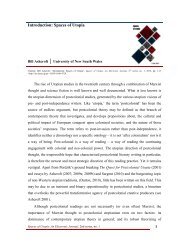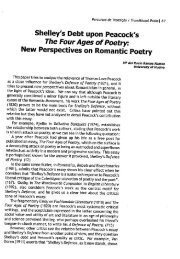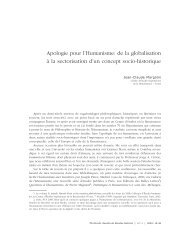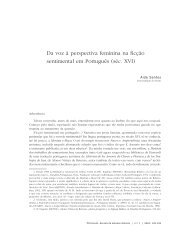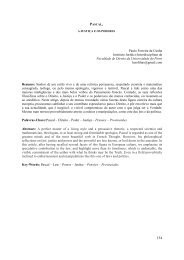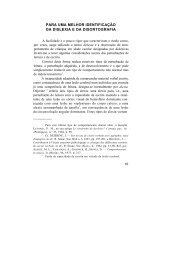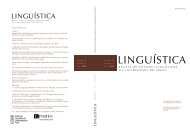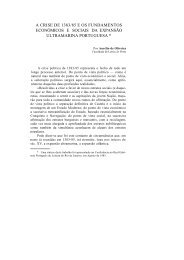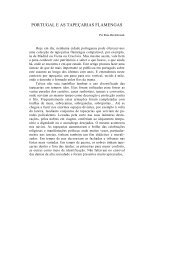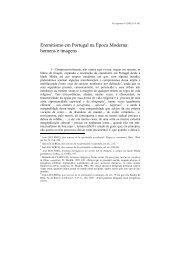Bilbo Baggins: An (Un)expected Hero
Bilbo Baggins: An (Un)expected Hero
Bilbo Baggins: An (Un)expected Hero
You also want an ePaper? Increase the reach of your titles
YUMPU automatically turns print PDFs into web optimized ePapers that Google loves.
<strong>Bilbo</strong> <strong>Baggins</strong>: <strong>An</strong> (<strong>Un</strong>)<strong>expected</strong> <strong>Hero</strong><br />
44<br />
Diogo Gonçalves<br />
FLUP - LLM<br />
Bravery, loyalty, strength, eloquence and shrewdness. These are some<br />
of the main characteristics we hope to find in a hero of an epic narrative. This<br />
idea of epic, originally introduced by the Homeric works, presents us to a hero<br />
who has superior virtues than the common man, to someone who is a natural<br />
leader, and is respected by his group not only for being so, but also because<br />
the group feels as well he is the one who deserves to lead them; the Homeric<br />
hero is someone that despite not being very humble among the ones of his<br />
race, knows that all he achieves is a gift of the Gods, so he must always serve<br />
them. The Hobbit of There and Back Again, a novella by J.R.R. Tolkien, can be<br />
certainly considered as an epic, but <strong>Bilbo</strong> <strong>Baggins</strong> is certainly not the classic<br />
hero…<br />
<strong>Bilbo</strong> <strong>Baggins</strong> is, in fact, sometimes considered as an anti-hero, so many<br />
are the differences between his nature and the classic hero’s. Throughout the<br />
story, <strong>Bilbo</strong> goes through many changes, being at the end of the narrative<br />
closer to the epic hero than he was on the beginning. This way, the biggest<br />
opposition that can be made between <strong>Bilbo</strong> and characters as Homer’s Ulysses<br />
or Achilles happens on the first chapters of The Hobbit. On these first chapters<br />
we can easily realize that this Hobbit is not as “heroic” as we might originally<br />
think: right away we notice that though curious, he’s not willing to embark on an<br />
adventure that might be dangerous. In fact, his origins are also a factor that<br />
influences him not to go – we are told that his <strong>Baggins</strong> side (his father’s family)<br />
is made of quiet and domestic people. Eventually, <strong>Bilbo</strong> “decides” to join the<br />
quest and though this journey will reveal itself as an initiating travel to <strong>Bilbo</strong>,<br />
soon we realize how this Hobbit is different from the classic hero. Since very<br />
soon, <strong>Bilbo</strong> longs for his home, happening this not only when he is in danger,<br />
tired and afraid, but also in moments when he is physically fit, as in Beorn’s<br />
house. <strong>Bilbo</strong>’s not especially strong or courageous; in fact, when the first<br />
problems emerge, <strong>Bilbo</strong> needs to be saved by the other members of the group,<br />
as happens in the confrontation with the Trolls, when is Gandalf that saves<br />
them. Moreover, the biggest signs of bravery <strong>Bilbo</strong> gives the reader happen<br />
when he finds the ring can make him invisible – <strong>Bilbo</strong> <strong>Baggins</strong> need to<br />
disappear in order to be daring enough to overcome the boundaries that<br />
eventually come out in his way. Like so, as he does not have superior qualities<br />
than the others, <strong>Bilbo</strong>’s certainly not in a leadership position among this group<br />
(Thorin is the one closest to being the leader).<br />
But <strong>Bilbo</strong> knows that that is not his natural territory, and even when he<br />
starts becoming useful for the group, he always haves a defensive posture,<br />
what can be seen, for instance, in the fact that he is humble; <strong>Bilbo</strong> doesn’t mock<br />
on those he defeats, as the classic hero tended to do (remember Ulysses<br />
mocking Polyphemus in Odyssey). As opposed to the classic epic hero, <strong>Bilbo</strong><br />
does not also fight great wars; he tends to be protected by chance and luck,<br />
what can be confirmed in the biggest brawl in The Hobbit, The Battle of the Five<br />
Armies, where <strong>Bilbo</strong> doesn’t take a direct part in because he was knocked out.
This also happens for the reason that <strong>Bilbo</strong> doesn’t have heroic intrinsic<br />
qualities, he grows as a hero as he overcomes the dangers, and even when his<br />
“heroic qualities” are in the highest level, he always seems very unsure about it,<br />
what gets to be proved in the very ending of the story, when <strong>Bilbo</strong> returns to be<br />
a domestic Hobbit – his character proved to be “round”: originally he is<br />
domestic, then adventurous, then domestic again, what confirms that, even in a<br />
now different way, <strong>Bilbo</strong>’s more comfortable in being a quiet Hobbit, than a risky<br />
one.<br />
<strong>An</strong>other issue that clearly separates <strong>Bilbo</strong> <strong>Baggins</strong> from the classic<br />
hero’s concept is the fact that he “betrays” his group. By giving the Arkenstone<br />
to Bard, knowing that was one of the items the Dwarves wanted the most, <strong>Bilbo</strong><br />
is accused of treason, something that was unthinkable for the classic hero. But<br />
this “treason” is directly connected with other difference between <strong>Bilbo</strong> and the<br />
classic hero – the fact that he is fair, rather than greedy. In the classic epics, the<br />
most the characters had, the better, bigger and powerful they were; this way,<br />
they didn’t think on fairness, because to them fair was to the best, to have the<br />
most, they weren’t as much concerned with issues regarding with fairness or<br />
justice as they were with power or status. But <strong>Bilbo</strong> is not like this, and he gives<br />
the Arkenstone to Bard, because he believed that that was the right thing to do.<br />
But not only of differences is the connection between <strong>Bilbo</strong> <strong>Baggins</strong> and<br />
the classic hero made; in order to be considered a hero, the Hobbit certainly<br />
shares some features of the epic hero, characteristics those who become quite<br />
clearer after the moment in which <strong>Bilbo</strong> kills the Spider all by himself. If the<br />
<strong>Baggins</strong> side of <strong>Bilbo</strong>’s family made him fear the adventure, his Took side (his<br />
mother’s) impelled him to go into the quest, what can be seen in the temptation<br />
he feels to say “yes” to the quest, temptation that that he had to fight back,<br />
when he remembered the possibility of a dangerous journey. But is after killing<br />
the spider that the hero in <strong>Bilbo</strong> reveals himself; from this point on, <strong>Bilbo</strong>’s<br />
bravery gradually increases.<br />
<strong>An</strong>other feature that <strong>Bilbo</strong> shares with the classic hero is the fact that he<br />
is very astute. Both <strong>Bilbo</strong> and the classic hero are not especially intelligent,<br />
erudite, but they think fast enough to get out of the situations they are in; <strong>Bilbo</strong><br />
is clever enough to survive to Gollum’s game and to wait for the right moment to<br />
escape from the Elves, when they imprison the Dwarves (in a quite similar way<br />
to the Odyssey moment in which Ulysses escapes from the Polyphemus’ cave).<br />
Also to take into account is the fact that even though <strong>Bilbo</strong> didn’t want to have<br />
responsibilities in that group, he always performs his duties, and he is always<br />
able to get out of the situations he is involved in, no matter how hard they are,<br />
being this factor connected with the fact that <strong>Bilbo</strong> (just like the classic hero) is<br />
protected by his heroic fate, that is to say, <strong>Bilbo</strong> is destined to perform great<br />
duties, so luck and chance are always protecting him.<br />
As in the classic epic narrative, in The Hobbit or There and Back Again<br />
all the secondary characters are placed in a position of helping or disturbing<br />
<strong>Bilbo</strong>’s quest. It’s quite clear that despite the existence of some fluctuations,<br />
there are no in between characters, every one is either good or bad. This<br />
division becomes quite clear in the Battle of the Five Armies, where we can<br />
easily see who is on each side; but on a deeper analysis of the main characters<br />
of the book, we can see that on the helpers side (those who will assist <strong>Bilbo</strong> in<br />
his quest) are Bard, Beorn, the Dwarves, the Eagles, the Elves, Elrond,<br />
Gandalf, Men and Roac. On the other hand, we have characters who will try to<br />
45
avoid the goals <strong>Bilbo</strong> has to achieve - the opponents (the Goblins, Gollum,<br />
Smaug, the Spiders, the Trolls and the Wargs). In a more extensive view, we<br />
could also consider <strong>Bilbo</strong>’s mother and father as, respectively, helper and<br />
opponent, once that according to the origins of each side of the family, his Took<br />
side made him felt the urge to go to the adventure, and his <strong>Baggins</strong> side made<br />
him not want to leave his home.<br />
Since very early it becomes clear that every character is either good or<br />
bad, and that the fluctuations that there are, are usually provoked by some kind<br />
of external interference: Thorin’s evil attitude is due to his thirst for gold;<br />
Gollum’s positive one is (though unintentionally) providing the ring, which will<br />
help <strong>Bilbo</strong> throughout the story. The fact that Gandalf puts <strong>Bilbo</strong> in a quest he<br />
didn’t want to be in, can also be considered as a fluctuation from helper to<br />
opponent, especially when Gandalf leaves the group, letting them in a position<br />
of almost no knowledge of what’s to come. The same happens with the Elves,<br />
when afraid of what the Dwarves might be up to, imprison them, making their<br />
quest harder and longer. Thorin’s obsession with gold, also puts <strong>Bilbo</strong>’s group in<br />
a rough situation, and shows the Dwarves’ selfish, mean and unfair side. By<br />
defeating the Trolls, the <strong>Bilbo</strong>’s fellowship also obtain weapons and the key to<br />
enter in Smaug’s cavern, so in an indirect way, the Trolls also help <strong>Bilbo</strong>’s<br />
quest. The same logic can be applied to the Spider, which, by dying, marks a<br />
changing point on <strong>Bilbo</strong>’s personality, converting him in a quite more<br />
courageous and decided character from that point on (in other words, the fact<br />
that <strong>Bilbo</strong> kills this spider, makes him quite closer to the classic hero’s<br />
conventions). This ambiguity of some characters can also be applied to Gollum,<br />
who, despite wanting to eat <strong>Bilbo</strong>, does not effectively harm the Hobbit’s quest<br />
and even provides him the (so useful in the rest of the story) ring.<br />
These fluctuations, however, should not make us doubt about the<br />
character’s classification as “helpers” or “opponents”, once that their natural<br />
intentions are quite obvious and revealing of in which side they are. The<br />
characters who fluctuate from one side to another show very clearly what they<br />
were up to: Thorin has a similar goal in this quest as <strong>Bilbo</strong>, and fights by his<br />
side; Gollum only unintentionally helps the Hobbit, and his main purpose was to<br />
eat him; Gandalf is the one who puts <strong>Bilbo</strong> in the quest, and often assists the<br />
group (he even saves their life in the Trolls episode); the Elves only imprison<br />
the group because they feared them; and obviously, neither the Trolls or the<br />
Spider wanted to be killed in order to help <strong>Bilbo</strong> and his group.<br />
All these parallelisms of The Hobbit of There and Back Again and the<br />
classic epic are sustained by a quite unique narration. The Hobbit is a story<br />
which is close not only to the classic epic, but also to the tale and subsequently<br />
to the oral tradition. These narrative strategies can be proved by both linguistic<br />
and aesthetical strategies. On the linguistic side, we have, for instance, the<br />
words written in accordance to the way the characters speak; by doing this,<br />
Tolkien emphasises the language and consequently the character of he who is<br />
speaking. As examples of this, we should take into account the Trolls’ accent,<br />
emphasising their arrogance and foolishness, or the Gollum’s sibilants,<br />
stressing his gloomy character (the fact that the words spoken for these<br />
characters are written in the way they pronounced them is another oral marker).<br />
<strong>An</strong>other narrative resource of The Hobbit is the fact that many places’ names<br />
are given after its physical characteristics, or to identify the peoples that live in<br />
46
that same place. This happens with (for instance) Hobbiton, Long Lake and<br />
Lonely Mountain.<br />
Also important are the aesthetical strategies introduced by J.R.R. Tolkien<br />
in this narrative. Throughout the story we find oral markers and typical elements<br />
of the tale and children’s literature, such as songs (that the Dwarves are<br />
constantly performing), riddles (as in Gollum’s cave), many repetitions (as the<br />
sentence “It was not the last time he wished that”), enumerations (as the<br />
constant references to the Dwarves name, and usually for a certain order<br />
“Thorin, Dori, Nori, Ori, Balin, Dwalin, Fili, Kili, Oin, Gloin, Bifur, Bofur, Bombur”)<br />
or the listing of actions (as happens in the conversation with Smaug, when the<br />
things <strong>Bilbo</strong> made are listed in an attempt to show that <strong>Bilbo</strong> was not as<br />
innofensive as Smaug might think, and, at the same time, remind the reader of<br />
the heroic attitudes the Hobbit had already performed). <strong>An</strong>other examples of<br />
aesthetic strategies are the use of “interrogatio” (a sequence of rethorical<br />
questions), as happens in the first time <strong>Bilbo</strong> sees Gandalf, and the use of<br />
epithets, such as “Thorin Oakenshield”, “son of Thrain, son of Thror” and “King<br />
under the Mountain” all applied to Thorin and that are another feature that<br />
approximates The Hobbit of There and Back Again to the classic epic, once that<br />
it was extremely usual in works such as Homer’s Iliad (think on the phrases<br />
“Son of Peleus”, “Swif-footed” or “God-like” applied to Achilles).<br />
<strong>An</strong>other central issue to take into account is the narrator itself. This<br />
narrator is an omniscient one, which means, that despite the fact that he is not a<br />
direct participant in the story, he knows both everything what happened, and<br />
what’s to come. In fact, he uses his knowledge of the future of the story to give<br />
hints on its development (remember the so many times repeated sentence “It<br />
was not the last time he whished that”). This hints the narrator gives are an<br />
element of comparison with Gandalf – the wizard shows himself as being the<br />
character with more knowledge of the future (“You will thank me before all is<br />
over”), and knowing so, he presents himself as being the wiser element of the<br />
group – as the same happens with the narrator, his words win credibility and the<br />
reader becomes eager to rely on what he relates. By knowing the whole story,<br />
the narrator has the freedom to control the times of the narration. He seems to<br />
give the more importance to the quest itself and to the defeating of Smaug<br />
(chapter 14), moment when the narration pace increases and the action speeds<br />
up, as if the main boundary was left behind. The returning home is only<br />
mentioned in telegraphic terms, despite the (more than probable) problems the<br />
group had to overcome, especially if we consider that they took a very similar<br />
way to the (so hard) route they took when they made the trip the other way<br />
round.<br />
By all these reasons, the approximation between The Hobbit of There<br />
and Back Again and the classic epic is inevitable, and subsequently the<br />
comparison betwenn <strong>Bilbo</strong> <strong>Baggins</strong> and the classic hero becomes unavoidable.<br />
This way, the main, and only character with his story closed at the end of the<br />
book, can be seen as a kind of “self-made-hero”, once that despite not beeing<br />
intrinsically heroic, <strong>Bilbo</strong> <strong>Baggins</strong> overcomes all the troubles that he has to fight,<br />
and works his way as a hero throughout the story. <strong>Bilbo</strong> <strong>Baggins</strong> is then the<br />
most heroic character and the only possible hero in an epic where are no…<br />
heroes...<br />
47



